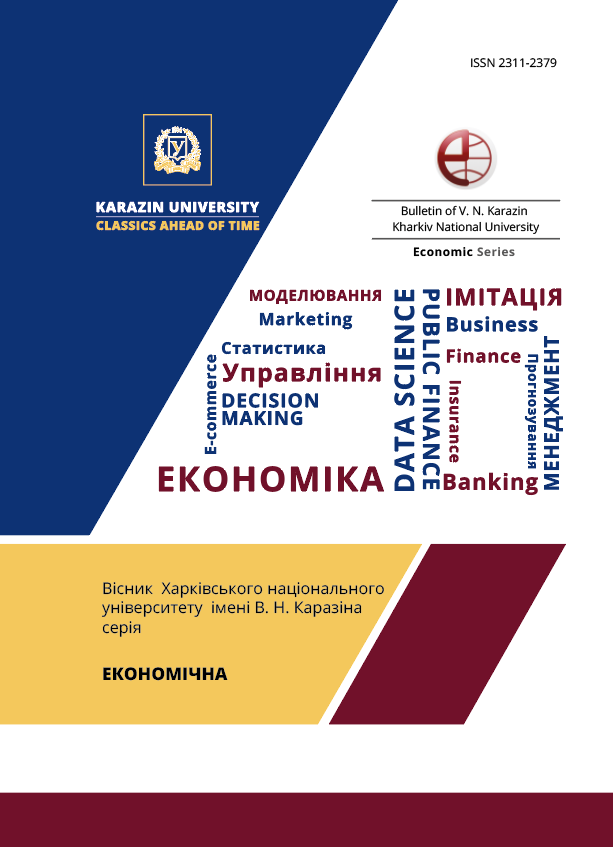Analysis of the agriculture sector of Ukraine during the war
Abstract
Russia's war against Ukraine has significantly increased food security risks and caused disruptions in agricultural production, supply chains, and trade, leading to unprecedented levels of global food and fertilizer prices. The current situation in the world agricultural markets by the middle of 2022 has shown the importance of the Ukrainian agricultural sector for the global market of agricultural products in general and the economy of the European Union, in particular. The article examines the place of the Ukrainian agriculture sector in the world agricultural market. The structure of export and import of agricultural products was analyzed. The dynamics of agrarian exports of Ukraine have been studied and the main reasons for its negative change have been determined. It has been established that the main problems during the war for the Ukrainian agrarian sector were: the occupation of Ukrainian territories, breaking of logistic chains inside and outside the country, reduction of the volume of the domestic market, and decreasing purchasing power of the Ukrainian population, insufficient resources for agricultural production, problems with labor force and theft of Ukrainian agricultural machinery and products. The domestic agricultural sector needs support from both the state and foreign funds, organizations, and countries. The Ukrainian government created several programs to support agricultural producers during military operations. In the tax, the support took place at the expense of VAT reduction, payment of taxes for FLP of 1 and 2 groups at will, payment of ERU by the state for the mobilized workers, cancellation of excise tax on oil products, etc. State support of the agrarian sector in the financial sphere is realized by providing access to cheap credits and the opening of new grant programs. Deregulation processes also took place at the state level: cancellation of business inspections, the introduction of the declarative system of business operation, and simplification of customs procedures. The prospects of the agricultural sector in the post-war economy have been studied. In particular, it was found that the key factor of agrarian sector development is people. Important for the recovery of the agricultural sector is the development of agricultural education and science, creation of sustainable chains in the regions, integration with competitive products into world markets, adaptation to the climate, sustainable and ecological agriculture, technological development, and digitalization of the agricultural sector.
Downloads
References
KSE Agricultural center. (2022). The total losses from the war in Ukraine's agriculture reached $ 4.3 billion USA. Retrieved from https://kse.ua/ua/about-the-school/news/zagalni-zbitki-vid-viyni-v-silskomu-gospodarstvi-ukrayini-syagnuli-4-3-mlrd-dol-ssha-kse-agrotsentr/. (in Ukrainian)
Nesterov, О. (2022). War, agriculture, VAT: what's new in the field of taxation. Retrieved from https://www.ucab.ua/ua/pres_sluzhba/blog/oleg_nesterov/viyna_agro_pdv_scho_novogo_v_sferi_opodatkuvannya. (in Ukrainian)
Trofimtseva, O. (2022). The war showed the importance of the agricultural sector. How to take new heights? Interfax Ukraine. https://interfax.com.ua/news/blog/839762.html. (in Ukrainian)
Banse, M. (2022). Der Ukraine-Krieg und seine Folgen: Auswirkungen auf die agrarpolitische Debatte Informations.
Câmpeanu, V. (2022). The Effects Of The War In Ukraine–The Global Food Crisis Becomes More Real. Euroinfo, 6(1), 3-15.
Celi, G., Guarascio, D., Reljic, J., Simonazzi, A., & Zezza, F. (2022). The Asymmetric Impact of War: Resilience, Vulnerability and Implications for EU Policy. Intereconomics, 57(3), 141-147.
Fiott, D. (2022). The Fog of War: Russia’s War on Ukraine, European Defence Spending and Military Capabilities. Intereconomics, 57(3), 152-156.
Glauben, T., Svanidze, M., Götz, L.J., Prehn, S., Jaghdani, T.J., Djuric, I., & Kuhn, L. (2022). The war in Ukraine exposes supply tensions on global agricultural markets: Openness to global trade is needed to cope with the crisis (No. 44e). IAMO Policy Brief.
Ghosh, N., & Bhowmick, S. (2022). Why India’s food value-chain needs better risk management instruments amid Ukraine war.
Oxford Analytica. (2022). Russian war aims and grain plans to fuel global crisis. Emerald Expert Briefings, (oxan-db).
Peterson, E. (2022). The Coming Global Food Crisis. Cornhusker Economics.
Ministry of Agrarian Policy and Food (Ukraine). 2022. Retrieved from https://mnagro.gov.ua.
Food and Agriculture Organization of the United Nations (FAO).(2022). Retrieved from https://www.fao.org/home/en.
KSE Agricultural center. (2022). Indirect losses in agriculture are estimated at $ 23.3 billion USA. Retrieved from https://kse.ua/ua/about-the-school/news/nepryami-vtrati-u-silskomu-gospodarstvi-otsinyuyutsya-u-23-3-mlrd-dol-ssha/. (in Ukrainian)
The Ukrainian Club of Agrarian Business. (2022). Retrieved from https://www.ucab.ua/.

